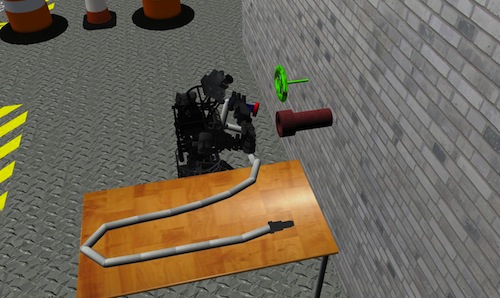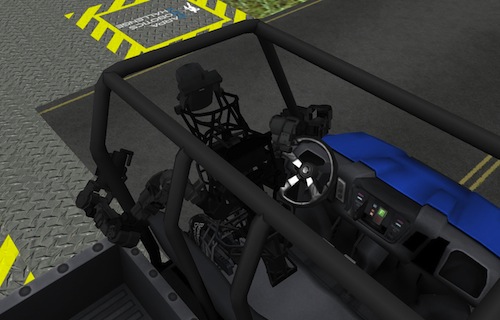June 27, 2013
Now taking center stage in the DARPA Robotics Challenge (DRC) is simulation technology that will allow competing teams to explore the viability of their ideas while helping the agency narrow the field of participants building robotics technology designed to aid in disaster-response operations.
At this month’s Virtual Robotics Challenge, which ran from June 17 though June 21, the 26 global teams that made the cut performed a series of pre-defined tasks using the Gazebo simulation environment, which was developed by the Open Source Robotics Foundation (OSRF). The participants were evaluated based on task completion and effective operator control of the robots in five simulated runs for three tasks addressing robot perception, manipulation, and locomotion. The tasks included: Entering, driving, and exiting a utility vehicle; walking across muddy, uneven, and rubble-strewn terrain; and attaching a hose connector to a spigot, then turning a valve. These, and the remaining tasks slated for the subsequent DRC trials to be held in December of this year and in December 2014, are based on feedback from firefighters, police, and nuclear engineers as to what they’d want a robot to do in the event of a disaster. In addition, to simulating communications limitations that would be typical of a disaster zone, the challenge imposed a round-trip latency of 500 milliseconds on data transmission as well as varying the total number of communications bits in each run.
The objective of the multi-phase DARPA DRC is to challenge competitors to develop new robotics technology capable of executing complex tasks in dangerous and degraded human-engineered environments using common tools and vehicles. It is also designed to support supervised, autonomous operation so the robots can complete their actual mission from beginning to end. As opposed to human operators giving step-by-step commands in terms of motion, these robots have a higher level of intelligence to respond to task-level commands like “open the door” or “climb the stairs.” This is necessary because of the degraded communications that characterize most disaster situations.
Dr. Gill Pratt, the DARPA program manager spearheading the competition, said the Gazebo environment showcases just how far realistic simulation has come. “The technology has advanced to allow simulation to be sufficiently valid and realistic so we can select the teams that will be most confident at running these tasks,” he said.
Pratt credits the work of the OSRF, which in Gazebo has designed a general-purpose tool that allows teams to simulate any and all ideas they might have for these robots, including models for motors, actuators, sensors, cameras, IMUs, and 3D sensors. “We want the simulation to be the best possible stand in for a real robot,” explains Brian Gerkey, CEO of OSRF. He says Gazebo may look and feel much like a video game, but it’s applicability goes much further. “It should be the case that the teams that do well in the Virtual Robotics Challenge should be able to take their software developed for the simulation environment and run it almost unchanged on their physical robot,” he says. “That is the test of how well we’ve done in building the software.”
With that in mind, Gerkey says OSRF has put a lot of time in honing the interactive capabilities of Gazebo so that a human operator sitting at the computer controls will have the feeling they are controlling a physical system.
Gazebo’s impact will also transcend the DARPA competitions. The open source code will be available to any research, educational, or private sector entity for incorporation in their product and for redistribution. “This is the most efficient development model for building a common platform the whole community can come to rely on,” Gerkey says. “It’s part of a broader effort to build a common ecosystem of software tools and libraries that everyone in robotics can use to do their work.”
Of the 26 teams from eight countries competing in the Virtual Robotics Challenge, nine teams are moving forward as opposed to the original target of six. The top six teams earned funding and an ATLAS robot designed by Boston Dynamics, which will allow them to compete in the subsequent physical competitions. In total, seven teams with ATLAS robots and DARPA support will be going to the DRC Trials, where they will compete with the Track A teams building their own robots.
For more information on the challenge, read “Robots to the Rescue” in Desktop Engineering’s June 2013 edition.
To hear OSRF describe Gazebo and the Virtual DRC tasks, watch the video below.
Subscribe to our FREE magazine, FREE email newsletters or both!
About the Author
Beth Stackpole is a contributing editor to Digital Engineering. Send e-mail about this article to [email protected].
Follow DE







